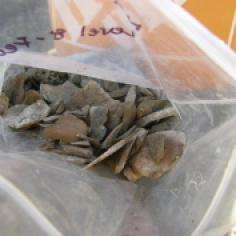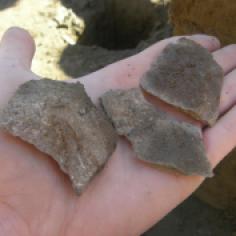
Pic: Alberta stratigraphy in the middle insert
I’ve mentioned a few times here or there that I’ve worked in several locations across Canada. While I can’t give you the number of sites I’ve worked on (are we supposed to be keeping count?), I can tell you that they’ve been in BC, Alberta, and Ontario. It’s a personal goal of mine to always get involved in the archaeology of the place where I’m living. And, in all honesty, a point of pride as well. I’ve been very fortunate to have been given all of these great opportunities to really see Canada’s prehistory as it’s represented across the country. And it dawned on me today, as I’ve been procrastinating getting any real work done at school, that I have a unique opportunity here to show off how different archaeology is across the country. Yeah, it’s all the same type of work – we shovel, we screen, we trowel, we get covered in dirt. But the contexts and what we encounter are all very different. So here’s a little visual representation for you about what archaeology is like in BC, Alberta, and Ontario, split into three entries because there will be a fair amount of photos taking up a lot of space.
Alberta
Let’s start with Alberta to keep things in alphabetical order. While in Alberta I was involved in a very large, very public bridge reconstruction project in the middle of Edmonton. The project involved spending some time pre-construction surveying for sites, excavating sites, and then monitoring whatever came up during construction. Which, at times, was actually a bit surprising. Who knew giant drills could pull up intact bison skulls, and 800-year-old elk antlers? Anyway, here’s a little taste of what Alberta archaeology looks like:
Pics: Top: Large hearth feature exposed (units were 1 m x 1 m); Bottom (L – R): rocks lining the east side of the hearth before we exposed it; looking down on top of the hearth before exposing it; the west side of the hearth as it appeared in the wall of the neighbouring unit
Pics: Top: Me excavating bison bones out of a large trench which had been excavated for a deep water line; Bottom (L – R): The intact bison skull (which was unique for many reasons, one of which being the position of its horns); bison bones in the wall of the trench from the top pic; giant bison bones compared to my hand
Pics: Top: stratigraphy as it appeared on our site (each black squiggly line represented a different flood event); Bottom (L – R): some of the thousands of flakes we found alongside the hearth feature (left and centre pics); one half of the rack of elk antlers which turned out to be 800 years old
Pics: Top: Me working outside in -35° weather; Bottom (L – R): me dramatically taking a photo of some black squiggly lines; me after a day going through the hydrovac mud; me enjoying some sunshine during lunch
Support Research and Outreach:
















